If you want to know what will happen if you don’t cycle a fish tank. Orr is it really necessary to cycle a fish tank then you are in the right place.
In this article, I am going to answer all these questions.
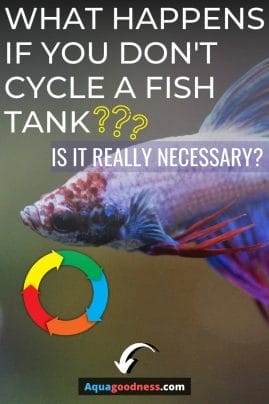
Table of Contents
So what happens if you don’t cycle a fish tank?
If you don’t cycle your fish tank then over time ammonia will build up in your tank.
As ammonia is toxic to fish, your fish will suffer from diseases and eventually will die.
Do I really need to cycle my fish tank?
I know, when you are just starting out, cycling a fish tank can be a very frustrating period.
But cycling your fish tank is necessary!
Why you asked!
To understand it let me tell you what cycling a fish tank actually is.
What is fish tank cycling?

Fish tank cycling is basically creating a healthy ecosystem in your fish tank for your fish.
By cycling your fish tank, you are actually replicating nature in your fish tank.
You may have heard about the food chain- every animal or organism is dependent on the other for food.
Fish tank cycling is similar to a food chain!
First, you feed the fish in your tank. Then the fish poops in the tank. The fish poop produces ammonia.
Now ammonia is very harmful to the fish. It stresses the fish and if you don’t get rid of ammonia from your fish tank then eventually you are fish will die.
So they are some microorganisms that are commonly known as beneficial bacteria or good bacteria in the aquarium hobby that consumes ammonia and converts it into nitrates.
Now nitrates are very less harmful to the fish.
Once your fish tank is cycled, it may contain a lot of nitrates but still, your fish will not be affected by it.
Overall, the cycle goes as follows-
Fish eats the food > The fish poops in the tank > The fish poop produces ammonia > The nitrifying bacteria or the beneficial bacteria or the good bacteria feeds on the ammonia and converts it into nitrites and then into nitrates.
Now nitrates are very less harmful to the fish. And your fish can tolerate a very high amount of nitrates (up to 50 PPM).
However, nitrates are still harmful to the fish. And once a lot of nitrates build up in your fish tank then you will need to remove them from your fish tank.
You can easily remove the nitrates by doing a partial water change on a weekly basis.
So overall, cycling your fish tank is very necessary to create an ideal environment in your fish tank.
15 Mistakes Beginners Make with their Goldfish Tank (How to avoid them)
Ways to cycle a fish tank
Basically, there are two ways to cycle a fish tank.
- Fish in cycling
- Fishless cycling
1. Fish in cycling
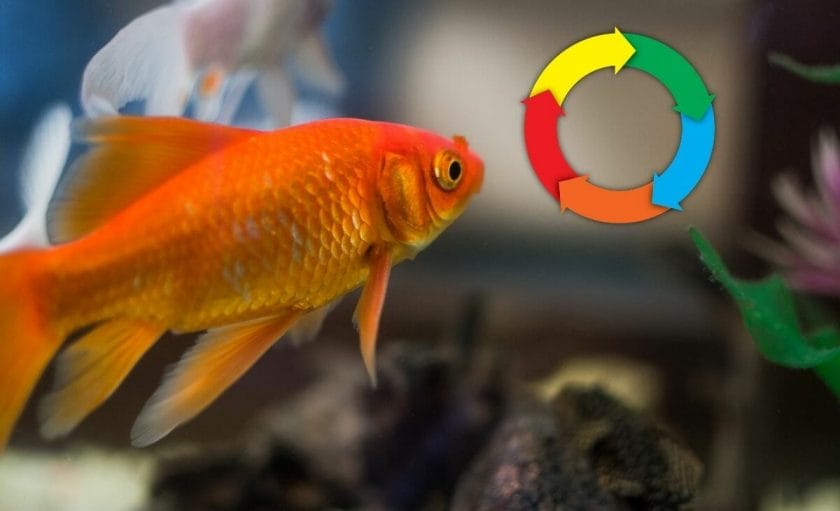
In fish-in cycling, you add fish in your fish tank from the very beginning even before cycling your fish tank.
Basically, you use fish to cycle your fish tank.
The theory goes like follows:
- You add a hardy species of fish in your fish tank
- You feed the fish
- After some time the fish will poop in the tank
- Then the fish poop will produce ammonia in the tank
- As the ammonia build up in the tank, you do a partial water change to reduce the ammonia level in your tank
- Eventually, the beneficial bacteria will build up in your fish tank to convert the ammonia into nitrites and then into nitrates
In the fish-in cycling method, you need to be very careful about the ammonia levels in your fish tank.
Ammonia is toxic to fish. So if you noticed even slight ammonia in your tank, you should immediately do a partial water change.
You need to check the ammonia levels on a daily basis. You can easily check the ammonia levels in your tank using a test kit.
I recommend API Test Kit. It is pretty popular and accurate. You can check its latest price and reviews at Amazon here.
If you noticed ammonia then do a partial water change. Usually, you’ll need to do a partial water change on a daily basis.
The problem with this approach is that the fish get stressed out due to ammonia in the fish tank.
Sometimes the ammonia builds up so much that the fish can even die in the tank.
Do I Need to Cycle My Tank Before Adding Live Plants?
2. Fishless cycling
In the fishless cycling method, as the name suggests, you don’t use a fish to cycle your fish tank.
Instead, you use different sources to produce ammonia.
A couple of common sources are as follows:
- Fish food
- Pure liquid ammonia
How to cycle your fish tank using fish food?
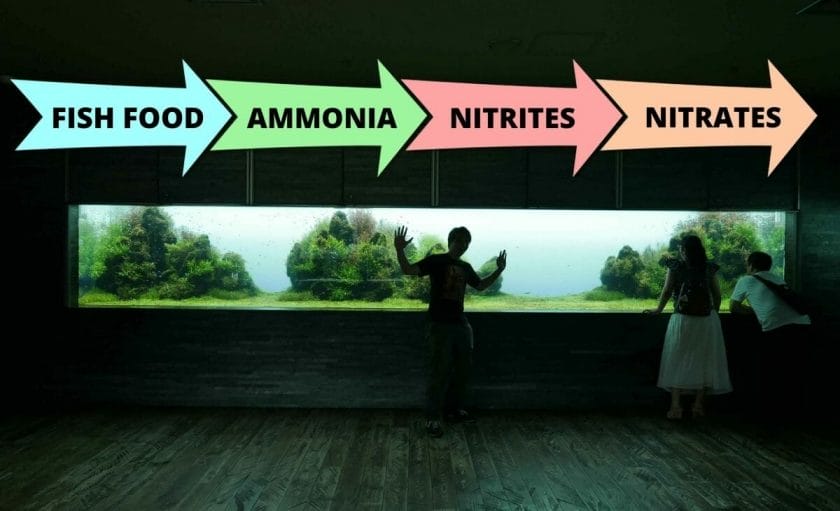
To cycle your fish tank using fish food you need to set up your fish tank- add substrate in your tank, add any ornaments if you like, add dechlorinated water in the tank, and then set up the filter
Once your fish tank is set up then you will need to add about a pinch of fish food in your fish tank.
Now you will need to wait for about a couple of days for fish food to produce ammonia in your fish tank.
After a couple of days check the water of your tank.
You can easily check the water of your fish tank using a test kit. I recommend API Test Kit. You can check it out at Amazon here.
At this time you should be noticing some ammonia in your tank.
Ideally, your fish tank should contain about 2-4 PPM of ammonia.
If the ammonia is in that range, great, now you just have to wait and check and maintain the ammonia.
If you noticed less ammonia than the ideal range i.e. 2-4 PPM then again add about a pinch of fish food in your tank.
If you noticed your fish tank has more than 4 PPM ammonia then, in this case, you will need to do a partial water change of about 50% of the tank water.
Basically, you will need to get the ammonia in the ideal range and maintain it by adding more fish food or doing a partial water change.
After sometime beneficial bacteria will start growing in your aquarium.
You can say that the beneficial bacteria are growing in your tank and your fish tank cycle has started when you started to notice drop in the ammonia level and some nitrite levels in your fish tank water.
Then after about a couple of weeks, you will start noticing some nitrate level in your tank.
When you notice 0 ammonia levels and 0 nitrites level and some nitrates level in your tank, you can conclude that your fish tank is cycled.
At this point, you can add fish in your fish tank!
Are Angelfish Good for Beginners?
How to cycle a fish tank using pure liquid ammonia?
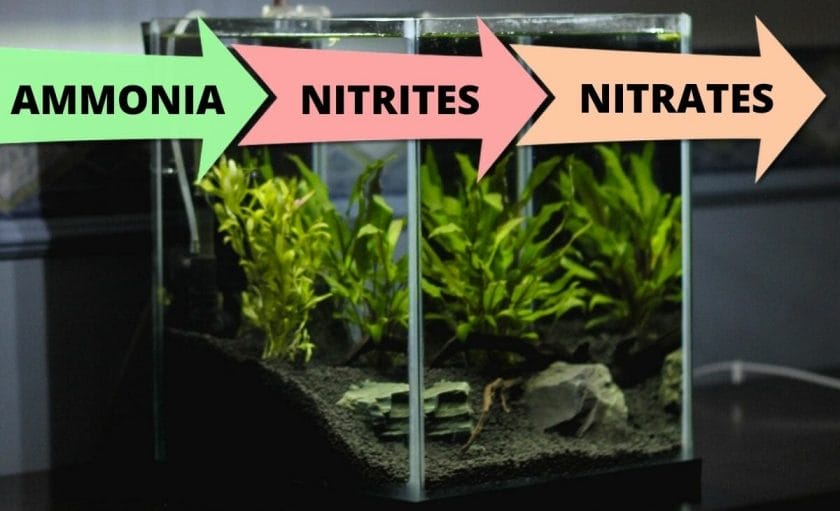
Cycling a fish tank using pure liquid ammonia is similar to cycling a fish tank using fish food.
Basically, instead of adding fish food in your tank and waiting for the fish food to produce ammonia in the tank, you are adding pure liquid ammonia in your fish tank.
Tip- While choosing pure liquid ammonia for cycling your fish tank make sure to choose the ammonia bottle which only contains liquid ammonia and doesn’t contain any other elements like send etc.
So be sure to read the ingredients list on the bottle while choosing ammonia for your fish tank cycling.
Once you have chosen the pure liquid ammonia bottle then you will need to set up your fish tank.
So add substrate in your fish tank, add ornaments if you like, then add dechlorinated water in your fish tank and set up an aquarium filter.
Then you will need to add a few drops of ammonia in the fish tank.
Now check the water of your fish tank for ammonia.
The reading should be between 2-4 PPM.
If the reading is lower than 2-4 PPM then you should add a couple of more drops of ammonia in the fish tank.
On the other hand, if your fish tank contains more than 4 PPM ammonia then do a partial water change to reduce the concentration of ammonia.
Once the ammonia level is between 2 to 4 PPM then you need to check the water of your tank on a daily basis for ammonia and nitrites. And maintain the ammonia levels between 2-4 PPM.
When you start noticing nitrites level in your fish tank then you can conclude that your fish tank cycle has started.
Still, you’ll need to maintain ammonia between 2-4 PPM. So if you noticed ammonia levels lower than that then add a few drops of liquid ammonia in the tank.
After a couple of weeks or so you will start noticing reduced ammonia and nitrites level and some nitrates level in your fish tank.
Again, you should maintain ammonia levels of 2-4 PPM.
The point at which you started noticing 0 ammonia, 0 nitrites, and some nitrates level in your fish tank then you can conclude that your fish tank is cycled and is ready to add fish into it.
How Long Does It Take To Cycle A Fish Tank? (Without And With Fish)
How to instantly cycle a fish tank?
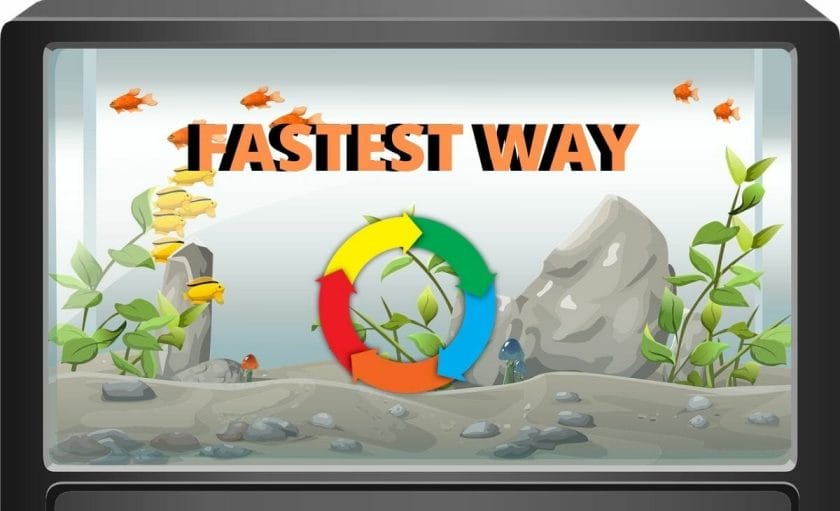
There are two ways to cycle a fish tank instantly.
- Adding filter or filter media from an established or cycled aquarium
- Pouring down beneficial bacteria in your fish tank
1. Adding filter or filter media from an established or cycled tank
The beneficial bacteria create their colonies in the filter or filter media of a fish tank.
So to cycle your fish tank instantly, get a filter or filter media from an established or cycled tank and put it in your fish tank.
This will instantly cycle your fish tank!
2. Pouring down beneficial bacteria in your fish tank
There are several brands that sell live beneficial bacteria in small bottles.
If you just pour down the bottle into your fish tank then you will have beneficial bacteria in your fish tank. And your fish tank will be cycled instantly!
The problem with the beneficial bacteria bottles is that, sometimes, by the time you get the bottle, the live beneficial bacteria in the bottle die.
Here are some of my recommendations for live beneficial bacteria bottles. A lot of people had good experience with them:
- Dr.Tim’s Aquatics Freshwater One & Only Nitrifying Bacteria- See its reviews at Amazon here
- Fritz Aquatics FritzZyme 7 Nitrifying Bacteria for Fresh Water Aquariums- See its reviews at Amazon here
Conclusion
When you are just starting out, cycling your fish tank may seem like a very long period.
But cycling a fish tank is a very essential part of creating a healthy environment for the fish in your aquarium.
That’s why you should always cycle a fish tank before adding the fish in your tank. Or else you may risk losing your fish.
If you want to instantly cycle your fish tank then you can use any of the above methods to add beneficial bacteria directly in your tank.
I hope you found this article helpful.
If you do, please share it
Good luck with your nitrogen cycle!
Related articles: